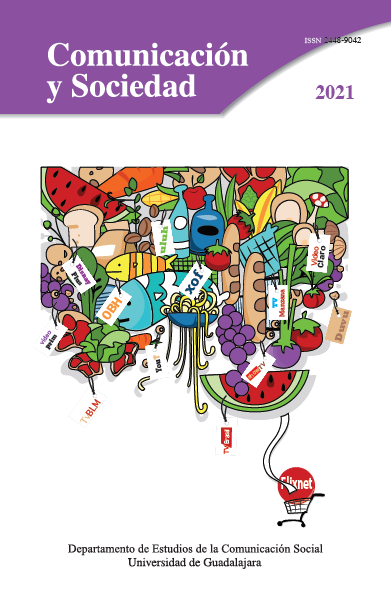Estrategias de interacción y comunicación de showrunners de series de ficción televisiva de Netflix en Twitter
DOI:
https://doi.org/10.32870/cys.v2021.7772Palabras clave:
Series de televisión, Showrunner, Audiencia, Netflix, TwitterResumen
Este artículo estudia cómo los showrunners se comunican con su audiencia en la red social Twitter. Tras una revisión literaria sobre el panorama televisivo derivado de la implantación de servicios de streaming y redes sociales, se analizan cuantitativa y cualitativamente las técnicas, el contenido y los elementos audiovisuales y textuales que utilizan en Twitter los showrunners de series originales de Netflix. A pesar de la heterogeneidad de su gestión, los resultados reflejan un uso reiterado del hashtag de la serie de televisión, de los tuits informativos/promocionales y de los enlaces externos.Descargas
Citas
Aguirre-Sacasa, R. [@WriterRas]. (25 de octubre 2018). One more pic to celebrate the #CAOS drop that’s happening tonight at midnight on #Netflix. Kiernan and Chance, on the [Image attached] [Tweet]. Twitter. http://bit.ly/2rq9g89
Aguirre-Sacasa, R. [@WriterRas]. (5 de abril 2019). Are you seeing doublesdoubles? Then you must be watching Ep. 119 of #Sabrinanetflix. Will the prophecy be fulfilled?? #CAOS [Image attached] [Tweet]. Twitter. http://bit.ly/2qC6qgj
Buschow, C., Schneider, B. & Ueberheide, S. (2014). Tweeting television: Exploring communication activities on Twitter while watching TV. Communications. The European Journal of Communication Research, 39(2), 129-149. https://doi.org/10.1515/commun-2014-0009
Calderón Kellett, G. [@everythingloria]. (8 de febrero de 2019). Next up 5808 Sunset Blvd. free @OneDayAtATime food truck!! Come out & let us feed you & give you high [Tweet]. Twitter. http://bit.ly/2DdP0sS
Carrillo-Bernal, J. (2018). Paradigma Netflix. El entretenimiento de algoritmo. Editorial UOC.
Cascajosa-Virino, C. (2016). El ascenso de los “showrunners”: Creación y prestigio crítico en la televisión contemporánea. Index Comunicación, 6(2), 23-40. https://bit.ly/2vKauxw
Cascajosa-Virino, C. (2018). Las series de televisión españolas ante la llegada de los servicios VOD (2015-2017). El Profesional de la Información, 27(6), 1303-1312. https://doi.org/10.3145/epi.2018.nov.13
Castro-Mariño, D. (2016). La audiencia social y el mundo narrativo de la ficción: Análisis de los comentarios de los fans y community managers sobre la ficción televisiva y webseries españolas. Palabra Clave, 21(1), 86-110. https://doi.org/10.5294/pacla.2018.21.1.5
Cornelio-Marí, E. M. (2020). Melodrama mexicano en la era de Netflix: algoritmos para la proximidad cultural. Comunicación y Sociedad, e7481, 1-27. https://doi.org/10.32870/cys.v2020.7481
Deller, R. (2011). Twittering on: Audience research and participation using Twitter. Participations. Journal of Audience & Reception Studies, 8(1), 216-245. http://bit.ly/33d4QPK
DuVernay, A. [@ava]. (22 de mayo de 2019). America was never great. There was always someone at the bottom. Someone being oppressed, enslaved, interned, caged, deported. How did [Video attached] [Tweet]. Twitter. http://bit.ly/37DZlwb
Fernández-Gómez, E. & Martín-Quevedo, J. (2018). La estrategia de engagement de Netflix España en Twitter. El Profesional de la Información, 27(6), 1292-1302. https://doi.org/10.3145/epi.2018.nov.12
Fernández-Manzano, E. P., Neira, E. & Clares-Gavilán, J. (2016). Gestión de datos en el negocio audiovisual: Netflix como estudio de caso. El Profesional de la Información, 25(4), 568-576. https://doi.org/10.3145/epi.2016.jul.06
Gallego, F. (2013). Social TV analytics: Nuevas métricas para una nueva forma de ver televisión. Index Comunicación, 3(1), 13-39. http://bit.ly/2JJ76H4
García-Avilés, J. A. (2012). Roles of audience participation in multiplatform television: From fans and consumers, to collaborators and activists. Participations. Journal of Audience & Reception Studies, 9(2), 429-447. http://bit.ly/2NcICYR
Guerrero, E., Diego, P. & Kimber, D. (2017). Hooked on lit screens. El Profesional de la Información, 26(6), 1108-1117. https://doi.org/10.3145/epi.2017.nov.10
Guo, M. (2019). Social television viewing with second screen platforms: Antecedents and consequences. Media and Communication, 7(1), 139-152. http://dx.doi.org/10.17645/mac.v7i1.1745
Halpern, D., Quintas-Froufe, N. & Fernández-Medina, F. (2016). Interacciones entre la televisión y su audiencia social: Hacia una conceptualización comunicacional. El Profesional de la Información, 25(3), 367-375. https://doi.org/10.3145/epi.2016.may.06
Harrington, S., Highfield, T. & Bruns, A. (2013). More than a backchannel: Twitter and Television. Participations. Journal of Audience & Reception Studies, 10(1), 405-409. http://bit.ly/2JGz46g
Hederson, J. [@Henderson_Joe]. (8 de mayo de 2019). A year ago, we were cancelled. Today, #LuciferSeason4 is on Netflix!! These episodes are for you, Lucifans. Thanks for fighting [Tweet]. Twitter. http://bit.ly/2DjSIRG
Higueras-Ruiz, M. J., Gómez-Pérez, F. J. & Alberich-Pascual, J. (2018). Historical review and contemporary characterization of showrunner as professional profile in TV series production: traits, skills, competences, and style. Communication & Society, 31(1), 91-105. http://bit.ly/326nPtV
Higueras-Ruiz, M. J., Gómez-Pérez, F. J. & Alberich-Pascual, J. (2019). Revisión histórica y conceptual de la autoría y sus implicaciones en el medio televisivo: el concepto de autor en las series de televisión contemporáneas estadounidenses. Doxa Comunicación, (28), 79-96. https://doi.org/10.31921/doxacom.n28a04
Izquierdo-Castillo, J. (2015). El nuevo negocio mediático liderado por Netflix: Estudio del modelo y proyección en el mercado español. El Profesional de la Información, 24(6), 819-826. https://doi.org/10.3145/epi.2015.nov.14
James, S. E. (2017). Early organization, commercialization and weaponization of social media in the entertainment industry: A case study, Bones, season 6 (2010-2011). Cogent Social Sciences, 3(1), 1-28. https://doi.org/10.1080/23311886.2017.1313927
Jenner, M. (2014). Is this TVIV? On Netflix, TVIII and binge-watching. New Media & Society, 18(2), 257-273. https://doi.org/10.1177/1461444814541523
Kemp, S. (2019). Digital 2019: Global Internet Use Accelerates. We are Social. http://bit.ly/2NarTp1
Lacalle-Zalduendo, C. & Gómez-Morales, B. (2017). La recepción televisiva española en la era multipantalla. Comunicación y Sociedad, (30), 197-216. https://doi.org/10.32870/cys.v0i30.6135
Latorre-Martínez, P., Orive-Serrano, V. & Íñiguez-Dieste, D. (2018). Medición y análisis de la audiencia social de las televisiones autonómicas en Facebook y Twitter. El Profesional de la Información, 27(5), 1061-1070. https://doi.org/10.3145/epi.2018.sep.10
Lin, J. S. & Peña, J. (2013). Are you following me? A content analysis of TV networks’ brand communication on Twitter. Journal of Interactive Advertising, 12(1), 17-29. https://doi.org/10.1080/15252019.2011.10722188
Lotz, A. D. (2016). The paradigmatic evolution of U.S. television and the emergence of internet-distributed television. Icono 14, 14(2), 122-142. https://doi.org/10.7195/ri14.v14i2.993
Marwick, A. E. & boyd, d. (2010). I tweet honestly, I tweet passionately: Twitter users, context collapse, and the imagined audience. New Media & Society, 13(1), 114-133. https://doi.org/10.1177/1461444810365313
Matrix, S. (2014). The Netflix effect: Teens, binge watching, and on-demand digital media trends. Jeunesse: Young People, Texts, Cultures, 6(1), 119-138. https://doi.org/10.1353/jeu.2014.0002
McNutt, M. (2018). Social TV fandom and the media industries. Transformative Works and Cultures, 26, 1-7. https://doi.org/10.3983/twc.2018.1504
Mittell, J. (2015). Complex TV. The poetics of contemporary television storytelling. New York University Press.
Navar-Gill, A. (2017). From strategic retweets to group hangs: Writers’ room Twitter accounts and the productive ecosystem of TV social media fans. Television & New Media, 19(5), 415-430. https://doi.org/10.1177/1527476417728376
Navar-Gill, A. (2018). The fan/creator alliance: Social media, audience mandates, and the rebalancing of power in studio-showrunner disputes. Media Industries Journal, 5(2), 19-34. http://dx.doi.org/10.3998/mij.15031809.0005.202
Newman, M. Z. & Levine, E. (2012). Legitimating Television: Media Convergence and Cultural Status. Routledge.
Ojer, T. & Capapé, E. (2013). Netflix: A business model in the distribution of audiovisual content. Journalism and Mass Communication, 3(9), 575-584. http://bit.ly/2pzBi0f
Pearson, R. (2010). Fandom in the digital era. Popular Communication, 8(1), 84-95. https://doi.org/10.1080/15405700903502346
Phalen, P. F. (2018). Writing Hollywood. The work and professional culture of television writers. Routledge.
Quintas-Froufe, N. & González-Neira, A. (2014). Audiencias activas: Participación de la audiencia social en la televisión. Comunicar, 22(43), 83-90. https://doi.org/10.3916/C43-2014-08
Quintas-Froufe, N. & González-Neira, A. (2016). Consumo televisivo y su medición en España: Camino hacia las audiencias híbridas. El Profesional de la Información, 25(3), 376-383. https://doi.org/10.3145/epi.2016.may.07
Rincón, O. (2011). Nuevas narrativas televisivas: Relajar, entretener, contar, ciudadanizar, experimentar. Comunicar, 18(36), 43-50. https://doi.org/10.3916/C36-2011-02-04
Scolari, C. A. & Establés, M. J. (2017). El ministerio transmedia: Expansiones narrativas y culturas participativas. Palabra Clave, 20(4), 1008-1041. https://doi.org/10.5294/pacla.2017.20.4.7
Segado, F., Grandío, M. M. & Fernández-Gómez, E. (2015). Social media and television: A bibliographic review on the Web of Science. El Profesional de la Información, 24(3), 227-234. https://doi.org/10.3145/epi.2015.may.02
Simons, N. (2014). Audience reception of cross-and transmedia TV drama in the age of convergence. International Journal of Communication, 8, 1120-1139. http://bit.ly/2N8vIe5
Van-Esler, M. (2016). Not yet the post-TV era: Network and MVPD adaptation to emergent distribution technologies. Media and Communication, 4(3), 131-141. http://dx.doi.org/10.17645/mac.v4i3.548
Wayne, M. L. (2018). Netflix, Amazon, and branded television content in subscription video on-demand portals. Media, Culture & Society, 40(5), 725-741. https://doi.org/10.1177/0163443717736118
Wright, B. [@bradtravelers]. (12 de diciembre de 2018). #Travelers drops this Friday Dec 14th! So, if you like season 3, tell the world! Good reviews and ratings on [Tweet]. Twitter. http://bit.ly/2ruyMJ6
Descargas
Publicado
Cómo citar
Número
Sección
Licencia
Derechos de autor 2021 María-José Higueras-Ruiz, Jordi Alberich-Pascual

Esta obra está bajo una licencia internacional Creative Commons Atribución-NoComercial 4.0.
Los autores/as que publiquen en esta revista aceptan las siguientes condiciones:
De acuerdo con la legislación de derechos de autor, los autores conservan los derechos de autoría y otorgan a Comunicación y Sociedad el derecho de primera comunicación pública de la obra. Comunicación y Sociedad no realiza cargos a los autores por enviar y procesar artículos para su publicación.
Los autores/as pueden realizar otros acuerdos contractuales independientes y adicionales para la distribución no exclusiva de la versión del artículo publicado en Comunicación y Sociedad (por ejemplo incluirlo en un repositorio institucional o publicarlo en un libro) siempre que indiquen claramente que el trabajo se publicó por primera vez en Comunicación y Sociedad.











